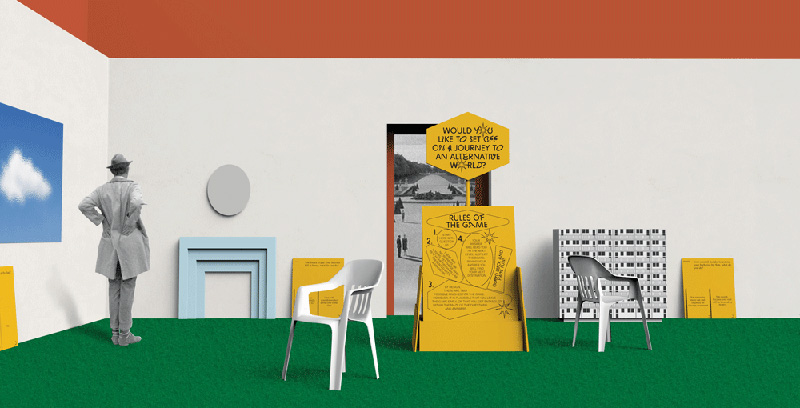By confronting two streams of (un)consciousness, Jeglinska and Czerniewska have chosen six concepts relating to the problems of the world of today. Distilled to abstract ideas (cloud, sun, house, high-rise, fossil, artificial intelligence) and presented in unexpected juxtapositions, these notions comprise fragments that amount to a symbolic anatomy of Utopia as an inventive tool for change.
Jeglińska and Czerniewska write:
From the very beginning, we knew it would be vital for us to actively engage viewers to participate in our project. We realised that we should position them as the narrative’s protagonists, and make them act according to a pre-designed choreography. Just like in More’s Utopia, we decided to place our audience on a mental journey to a different land, familiar and uncanny at the same time.
Similarly to fairytales and fables, the utopian genre stimulates the imagination, motivating the audience to embark on a voyage. The mental journey to Utopia enlightens and sensitises a person to their surroundings – a critical analysis of the present suggests potential solutions and scenarios for the future. Jeglińska adds:
By now, the road from the outset of a thought to its implementation has become terrifyingly short. What we have previously witnessed as science-fiction narratives are creeping into reality. This is equally a blessing and a curse, sometimes independent of the original intentions.
The creators of the exhibit assert that ‘living in a post-utopian, postmodern age, we have come to a realisation that utopias are human-made constructs, which upon their implementation turn out to be nightmares (dystopias).’
 Cadavre Exquis: An Anatomy of Utopia, an excerpt from the exhibition's design by Maria Jeglińska & Klara Czerniewska, 2016, photo: press materials
Cadavre Exquis: An Anatomy of Utopia, an excerpt from the exhibition's design by Maria Jeglińska & Klara Czerniewska, 2016, photo: press materialsThe inaugural London Design Biennale will feature presentations from curators and designers representing thirty countries across six continents. A talented roster of international creatives and industry insiders will explore how design and innovation can make the world better with the event’s guiding motif, Utopia By Design. All participants, including the world’s most influential museums and cultural institutions such as Cooper Hewitt, Smithsonian Design Museum (USA), the Triennale Design Museum (Italy), and the Victoria and Albert Museum (UK), have developed thought-provoking installations that ponder the concept of utopia and the impact of design.
Culture.pl values the collaboration with the London Design Biennale as a welcome opportunity to promote Polish design, its key protagonists and most valid ideals and trends. ‘The collaboration with the London Design Biennale has been one of Culture.pl’s cornerstone initiatives in the promotion of Polish design throughout 2016, along with the exhibition Beauty & Pragmatism / Pragmatism & Beauty displayed at the Triennale di Milano,’ says Barbara Krzeska, head of the Polska Design project at the Adam Mickiewicz Institute. ‘Procuring such prestigious partners will enhance the reputation of Polish design and Polish designers in the international arena.’
The Polish Pavilion promises to be a provocative and complementary addition - a must-see for artists, curators, and designers alike.